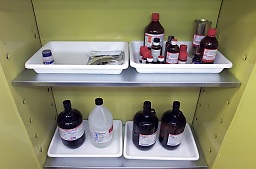
Store all hazardous liquid chemicals in secondary containment, such as drip trays. This is to minimize the impact and spread of a spill resulting from broken/leaking containers. Tray capacity must be 100% of the largest container.
Drip trays are available in different materials which provide varying resistance to chemical attack. It is important to use chemical resistance data to select the proper material when using plastic drip trays. This is discussed in more detail below. Avoid using aluminum roasting pans. They do not offer good resistance to corrosive chemicals such as acids and alkali bases. Moreover, disposable roasting pans are flimsy and will develop cracks and tears.
- Photo trays
- Generally, these provide good resistance for aqueous solutions and some organic solvents, but may not be a good choice for halogenated solvents
- Photo trays are available through several commercial sources, including VWR Scientific. An additional source of spill containment trays is Scientific Plastics. This company provides trays in several depths, with width and length in 1” increments.
- Polypropylene and Hi Density Polyethylene
- These are subject to attack by some aromatic and halogenated hydrocarbons.
- The Nalgene website has a chemical resistance database for these materials
- Stainless Steel and Pyrex
- Stainless steel and Pyrex trays are resistant to a broader spectrum of chemicals. However they are more expensive than plastic trays and aren’t available in as many different sizes and configurations.
- Glass trays or beakers are required as secondary containment under perchloric acid
